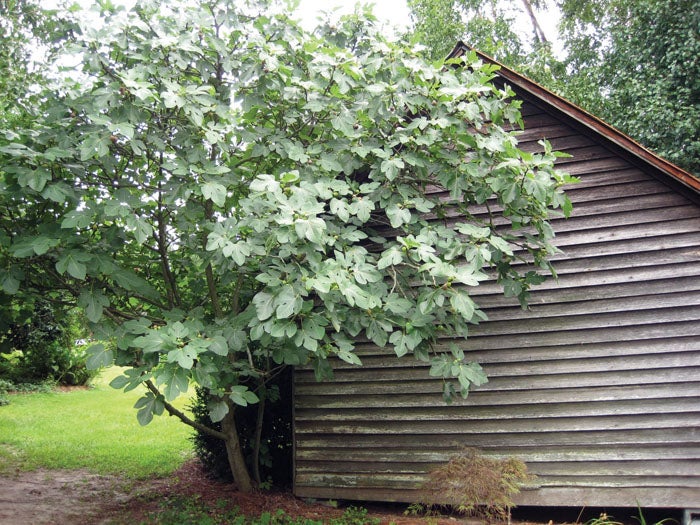4H plant sale going on now
Published 12:00 am Saturday, September 24, 2022

- This fig tree is growing on the north side of a building — submitted photo
By Amy-Lynn Albertson
N.C. Cooperative Extension
It’s time for the 4-H plant sale again, and we have a few fun new additions this fall. We have elderberries this year. Elderberry, American elder Sambucus canadensis, is an attractive, relatively large shrub whose flowers and berries can make an array of medicinal, food and beverage products. It is native to N.C. growing along streams, marshes and moist forests. It is an arching shrub/small tree with white creamy, fragrant flowers and purple drupe berries. The elderberry is tolerant of almost all soils but prefers rich, moist acidic soils grown in the sun to partial shade. Use this plant in naturalized areas, as a hedge or along streams and ponds. Elderberry is used for erosion control in moist sites. Butterflies and other insects are attracted to the blooms. Mammals and many species of songbirds eat their fruits. It is an excellent bird nesting site and provides cover for quail and pheasants. Deer browse the leaves, twigs and fruit. You can use the cooked berries for jams, jellies, syrups, juices, wine and more. Cooked is the keyword. The berries raw are poisonous to humans. They can also be a problem for horses. We have two varieties for sale York and Adams. They are in 3-gallon containers for $25/each.
If you are looking for a small fruit to produce in your backyard, Blackberries may be the fruit for you. Blackberries are of two types: semi-trailing thornless and erect. Semi-trailing thornless blackberries have canes that are not self-supporting; they must be tied to poles or trellises. The fruit ripens about one month after that of the erect type. The semi-trailing variety should not be grown in areas where winter temperatures may drop below 0 degrees. Erect blackberries can tolerate temperatures slightly below 0 degrees without significantly damaging canes. Erect blackberries are the type of blackberry commonly grown in the Piedmont. Erect blackberries still need a little support. You can grow them with a fence post or put them in a two-wire trellis system. We have several erect blackberries for sale this year Apache, Arapaho, Navaho and Ouachita in 1-gallon containers for $12 each. These blackberries have larger berries than our native blackberries and will produce fruit in the first season after planting.
We have peaches and figs this year if fruit trees are your jam. Peaches and figs don’t require a pollinator, so they are a great option if you have a small lot and would like just one fruit tree. We have Contender and Red Haven varieties of peaches which require longer chilling hours. This means they will bloom later in the spring and hopefully not get hit by our spring freezes. Peaches are in 5-gallon containers and $27 each. Figs can also be grown as a tree or large shrub. I have a fig tree growing next to my house in my side yard. It’s about 12 feet tall. Figs are not cold-hardy, so they need to be planted in protected areas like pomegranates. However, they have very few diseases and insect problems. Sometimes we are lucky and get two harvests of figs, one in mid-summer and a second in late summer (August, September). We have Brown Turkey and Celeste figs for sale in 1-gallon containers for $12 each.
Maybe you need more nuts in your life; we have pecan trees this year. They are in five-gallon pots for $42/tree. The pecan or Carya illinoinensis is a large tree growing to 70 feet tall and a canopy of 130 feet across. You must plant pecans at least 30 feet from structures and in full sun. Good drainage is essential for pecans to grow well. They must also be cross-pollinated (usually by the wind) to reproduce or make nuts. If there are plenty of pecan trees in your neighborhood, you can get away with planting just one. However, if you are the lone pecan gardener in your area, you might need to plant a couple to get harvestable nuts. We have two varieties for sale, Elliott and Caddo. Alas, don’t be promising a tasty pie with nuts from your newly planted pecans. You’ll have to wait six to 10 years after planting before getting a good crop of nuts. And then, don’t be surprised if you get a great crop one year, followed by a small or nonexistent crop the next year. If a pecan senses drought conditions one autumn, it will “turn off” nut production for the following year. This is how it evolved to deal with stressful situations.
Pecans are ready to eat when the husks crack open. Most folks pick up the nuts after they’ve fallen to the ground. However, you want to get to them before they rot or wildlife gets to them. The nuts are generally ready for harvest in October or November, and a mature tree will produce 40 to 50 pounds of nuts per year.
We have several other fruit plants for sale, muscadines, pomegranates, gogi berries, raspberries, apples and blueberries. Inventory is limited. Call 704-216-8970 and place your order soon. The deadline for orders is Thursday, Oct. 27, and the pick-up day is Nov. 3. Go to rowan.ces.ncsu.edu to see the list of available plants and prices.
Amy-Lynn Albertson is director of the Rowan County Extension.




